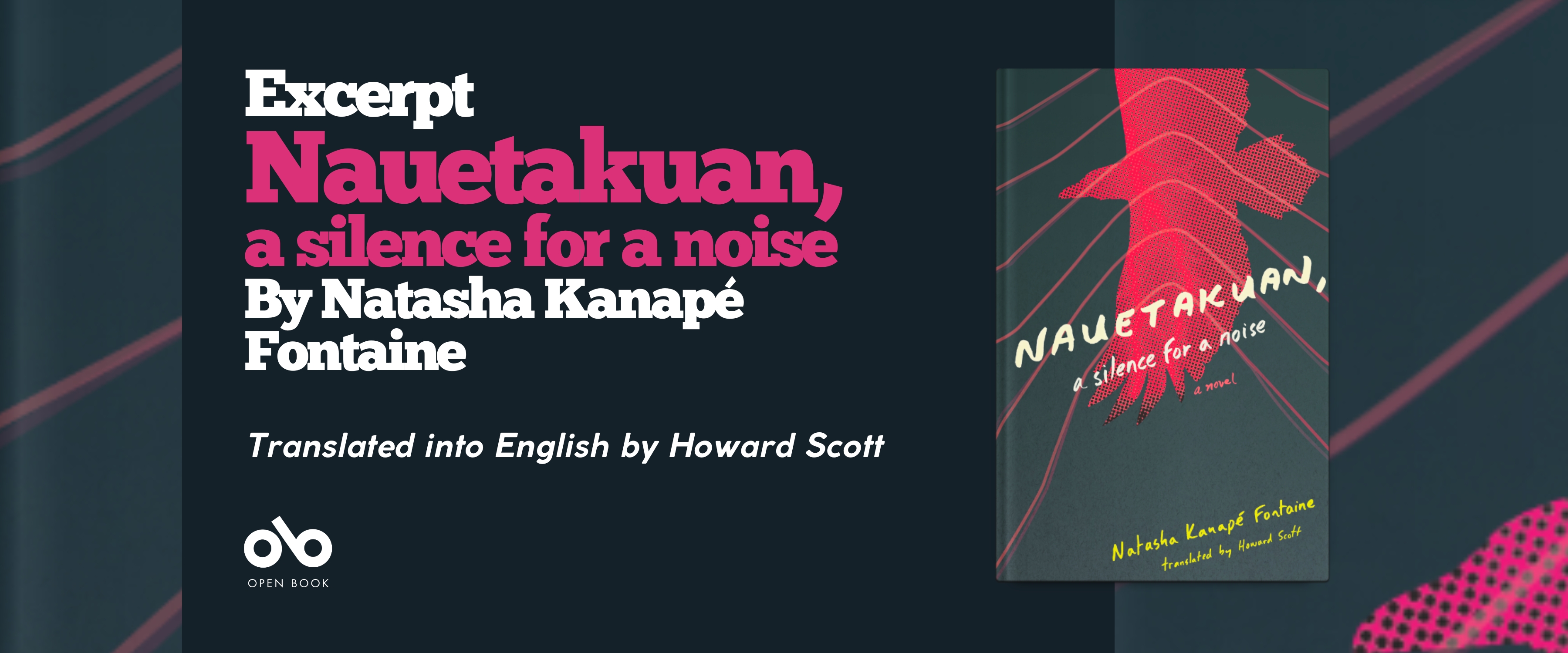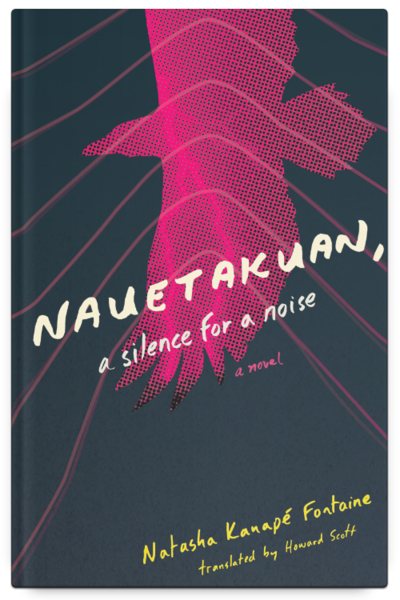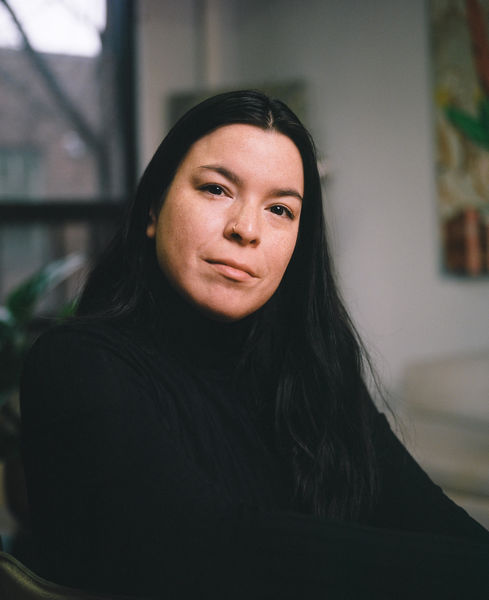Read an Excerpt from Nauetakuan, a silence for a noise by Natasha Kanapé Fontaine
Reconnection and rediscovery are at the heart of the newly translated novel by Innu author, Natasha Kanapé Fontaine, and her poetry and essays have already left an imprint on the literary world in the lands that we now call Quebec, and far beyond. Originally from Pessamit, on the Nitassinan (North Shore, Quebec), Fontaine now writes out of Tio’tia:ke, which is known as Montreal, and her spellbinding skills of storytelling are on full display in her latest work.
In Nauetakuan, a silence for a noise, the reader follows a young woman as she studies art history in Montreal, her Innu roots now distant to her. But only until she happens upon an art exhibition that reaches her core and articulates a deep, intergenerational wound. With all of this stirring in her, Monica begins a search to connect more strongly with her Indigeneity, leading to a new friendship with Katherine, an Indigenous woman who is steeped in culture and community.
Not content to simply stay in Montreal and the surrounding areas, Monica ventures across the continent to connect and share knowledge and culture with Indigenous artists and thinkers from many nations. But she is also visited and guided by visions of giant birds and ancestors who call her back to Pessamit, her homeland, where her path will continue and where she will truly find her language and people.
We're very happy to share a passage from Nauetakuan, a silence for a noise with our readers, and encourage you to journey further into the novel.
An excerpt from Nauetakuan, a silence for a noise by Natasha Kanapé Fontaine, translated by Howard Scott
I decide to leave the house and head down the sandy slope where the cars are parked, and I cross Kesseu Street to take the path that runs past the house across from ours.
Along that trail, the trees are gigantic. The leaves are soaked and shine lush green under the July sun of the Innu summer. The mosquitoes are dancing, and other big insects swirl around, frightening me. Their wings hum and I keep walking, past the convenience store and the sign announcing that the proprietor’s name is Florence.
I cross another street without slowing down, and I come to the little white house. I can barely climb the wooden stairs. The door is wide open to visitors, and the windows are full of brown plastic dolls, leather shoes, and tanned leather coats with hand-embroidered flowers.
No one pays attention to me, a five-year-old girl walking behind the display cases and through the doorway with its hanging strips of leather decorated by multicoloured beads. There are all kinds of Innu women busy with moccasins, dolls, leather clothing. Under the fluorescent lights, they are embroidering patterns, pushing shiny needles through the hides. I’m looking for my grandmother.
“Kukum!”
Your CanLit News
Subscribe to Open Book’s newsletter to get local book events, literary content, writing tips, and more in your inbox
The women start laughing. Their voices get louder, and a new wave of laughter sweeps through the room. I run past them, between their work tables. My grandmother comes in through the back door, which is also wide open, in the late afternoon light when the sun turns orange, wrapping the village in its warmth, just before the evening refreshes us. Outside, to one side, women are smoking their cigarettes, taking a well-deserved break.
“Tshekuan tuman uteshen! Tanite ma tat tshekaui!”
What am I doing here?
“Tshidapedem la télé nekaui…”
My mother is watching television at home. She thought I was playing quietly with my toys, but I left the house and ran to the shop.
My kukum sits back down in her chair and takes me on her lap to show me what she’s working on. It is the upper of a moccasin, which she is decorating with a symmetrical white-and-mauve flower.
She takes my little hands in hers and slips a thimble on my index finger. She helps me place it on the end of the needle, which pierces the leather, pushing my finger with hers. I’m sewing! Her hands, browned by the sun, wrap around mine, dirty from the sand in the yard.
“Ekuene nituassim!”
That’s it, my child. You push the needle into the leather, it goes through to stitch the purple thread, and then it will cross time and space. And we’ll be there on the other side. Some say that will be the end. In truth, it will be the beginning.
Monica undoes her seat belt as the car rolls down the slope on Ashini, the street that brings you into the village. She presses the button to open the window on the passenger side. The breeze comes in, cool. Monica closes her eyes. Her hair is dancing.
She smells the fragrance of the fir trees and breathes in the aroma of the Saint Lawrence River. She shivers.
Katherine, back at the wheel after the last fill-up, watches her friend out of the corner of her eye. She smiles, glancing at the trees, the big hill that overlooks the first houses coming up on the left. On the right are the police station and the fire station. The Pessamit convenience store.
“You can continue to the end of the street, and you’ll see the Saint Lawrence. I’d like to stop there first,” Monica murmurs to her best friend, opening her eyes.
Katherine nods without speaking. The smile fluttering on her lips seems to say everything.
“There’s my grandmother’s house. Where I grew up, before Forestville.”
Monica points to the right, and Katherine gets a brief glimpse of the white-and-royal-blue house. Sturdy trees with little red berries honour the house with their beauty. Driving very slowly, not going over the regulation thirty kilometres an hour, they continue on their way.
“How are you feeling?” Katherine speaks very softly to Monica, as if she doesn’t want to disturb her friend’s homecoming.
Monica looks at the passersby, who in turn gaze at the car and its occupants. Each house reminds her of something. A person, a moment from childhood, when she walked in the streets with other children. Of course, she doesn’t remember their faces anymore. “I feel good. For now.”
Monica had no trouble convincing Katherine to go with her to Pessamit. Before leaving Mexico City, she was already planning to make the trip, only she didn’t know right away when exactly she would be able to follow through, or if she was really ready. Maybe there would be so much she needed to clarify before going that the return would be perpetually postponed. Finally, after a few suffocating weeks in the mugginess of the Montreal summer, working on a few articles about various Indigenous artists in Vancouver whose work she had really enjoyed, and other writing that was a little more for herself, and also exchanging a few emails with Oscar, the inner call came, and it was a lot stronger than anything she could have imagined. From that moment on, everything quickly fell into place.
The car, borrowed from Katherine’s mother, who had left on her annual Sun Dance circuit and was happy to encourage her daughter to discover the North Shore, rolls on as far as the presbytery and the church beside it, both facing the Saint Lawrence. The young women gaze at the windswept, decades-old church on the coast. Looking farther to her right, Monica notices two families with three young kids coming out of the health centre, walking fast, looking happy. The people are smiling. Every person they’ve encountered since arriving was smiling or laughing heartily in the summer sun.
After stopping at the intersection next to the presbytery, they cross Laletaut Street, and Katherine parks on the other side, on a patch of gravel across from the expanse of water. In front of them, a steep slope leads down to grass, tidal flats, and the sand beach.
“This is it, this is your home. What do you want to do?” Katherine asks, stepping out of the car to get a breath of fresh air off the Saint Lawrence. Monica decides to do the same thing.
“I feel like taking a walk on the beach. How about you?”
“Yes, I’ve been anxious to see the beach ever since Gabriel raved about it. The weather’s so nice too.”
Monica turns toward the beach, where she doesn’t see anyone. Despite the beautiful weather, they will have the beach to themselves.
Going down the sand road, which turns into a path winding through the grass, they come to the shore. The place is peaceful, in spite of a few cars passing on Laletaut Street and the sound of children in the distance. When they come to the edge of the water, everything has gone calm, everything has slowed down, and a silence filled with the white noise of the waves takes hold. The breeze joins in, starting to sing in the quiet.
Here, the path goes either to the right or the left, following the shore that runs along the village and where all the streets end.
A vague memory comes back to Monica and prompts her to head west. In that direction, the sand runs along Metsheteu Street, which has the same name as the bay where it ends, at the estuary where the Betsiamites River flows into the Saint Lawrence.
___________________________________
Natasha Kanapé Fontaine is an Innu writer, poet, and interdisciplinary artist from Pessamit, on the Nitassinan (North Shore, Quebec). She lives in Tio’tia:ke, known as Montreal. Her critically acclaimed poetry and essays are widely taught and have been translated into several languages. In 2017, she received the Rights and Freedoms Award for her poetry and contribution to bringing people closer through art, writing, performance, dialogue, respect, and cultural exchange. In 2021, she received the Chevalier de l’Ordre des arts et des lettres de la République française. She also works as a translator, screenwriter, sensitivity reader, and consultant on Indigenous literature.
Howard Scott is a literary translator living in Montreal who translates fiction, poetry, and non-fiction, often with Phyllis Aronoff. He received the Governor General’s Literary Award for Translation for The Euguelion by Louky Bersianik and, with Phyllis Aronoff, won the Quebec Writers’ Federation Translation Award for The Great Peace of Montreal of 1701 by Gilles Havard. The translating duo were also awarded a Governor General’s Literary Award for their translation of Descent into Night by Edem Awumey. Scott is past president of the Literary Translators’ Association of Canada.






